Salsa Journeyer GRX 700c review - perfect for those just starting to explore gravel
Salsa’s Journeyer is a versatile gravel bike that’s just as comfortable eating up easy dirt road miles as on a multi-day bikepacking trip
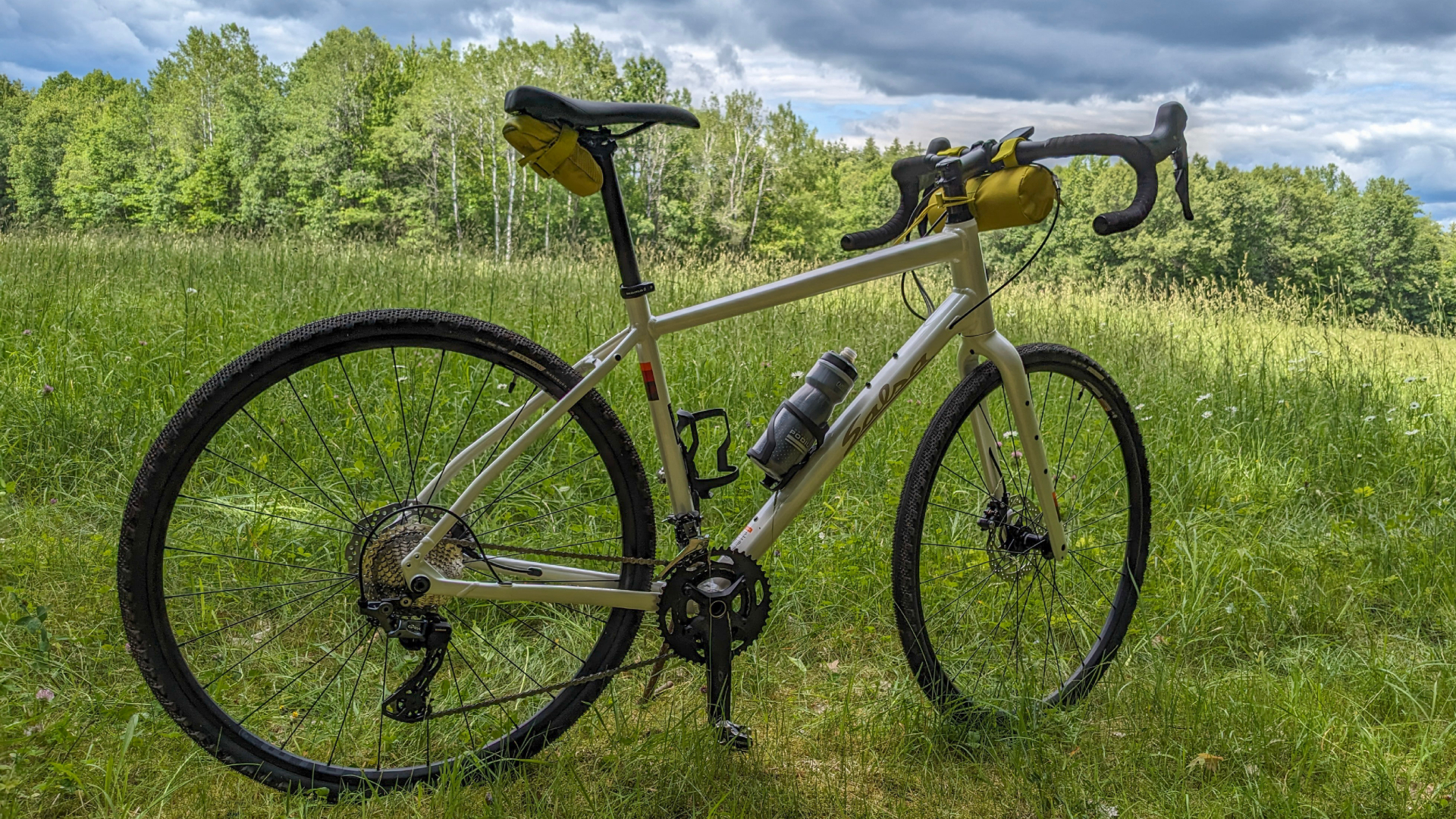
The Salsa Journeyer GRX 700c is a versatile bike that adapts to numerous types of riding, making it an excellent option for new gravel riders and those unsure what riding style most appeals to them. Although the bike doesn’t dazzle in any particular area, it provides a fun and confidence-inspiring ride, which will please long-time riders and hook new ones.
-
+
Predictable and fun performance
-
+
Inspires confidence in a variety of terrains
-
+
An abundance of mounts
-
+
Nice part spec
-
+
Available in a variety of builds
-
-
Doesn’t shine in any one area
-
-
Wish it came with beefier tires
-
-
At the high end of 'budget' bikes
You can trust Cycling Weekly.

The Salsa Journeyer GRX 700c is stunning looking in white and it certainly stands out in a segment seemingly dominated by dark-colored bikes.
When I first unboxed the bike, I questioned the logic of painting such an adventurous-looking machine in a color sure to show the mud, dirt, and grime that accompany gravel rides. However, after hundreds of hard miles filled with every type of dirt imaginable and a spill (or two) on some slick singletrack, the bike still looks fantastic. While the white paint has encouraged a more robust than normal cleaning regimen, it has held up far better than expected.
Salsa Journeyer 700c: construction
The Salsa Journeyer GRX 700c is a well-appointed machine that’s ready to tackle everything from easy asphalt to snaking singletrack using a number of trusted parts and specs. At a glance, it features:
- An aluminum frame and carbon fork
- Tubeless-ready WTB wheels with Teravail tires
- A nice mix of Shimano GRX components
- An abundance of cargo/bottle mounts
The frame
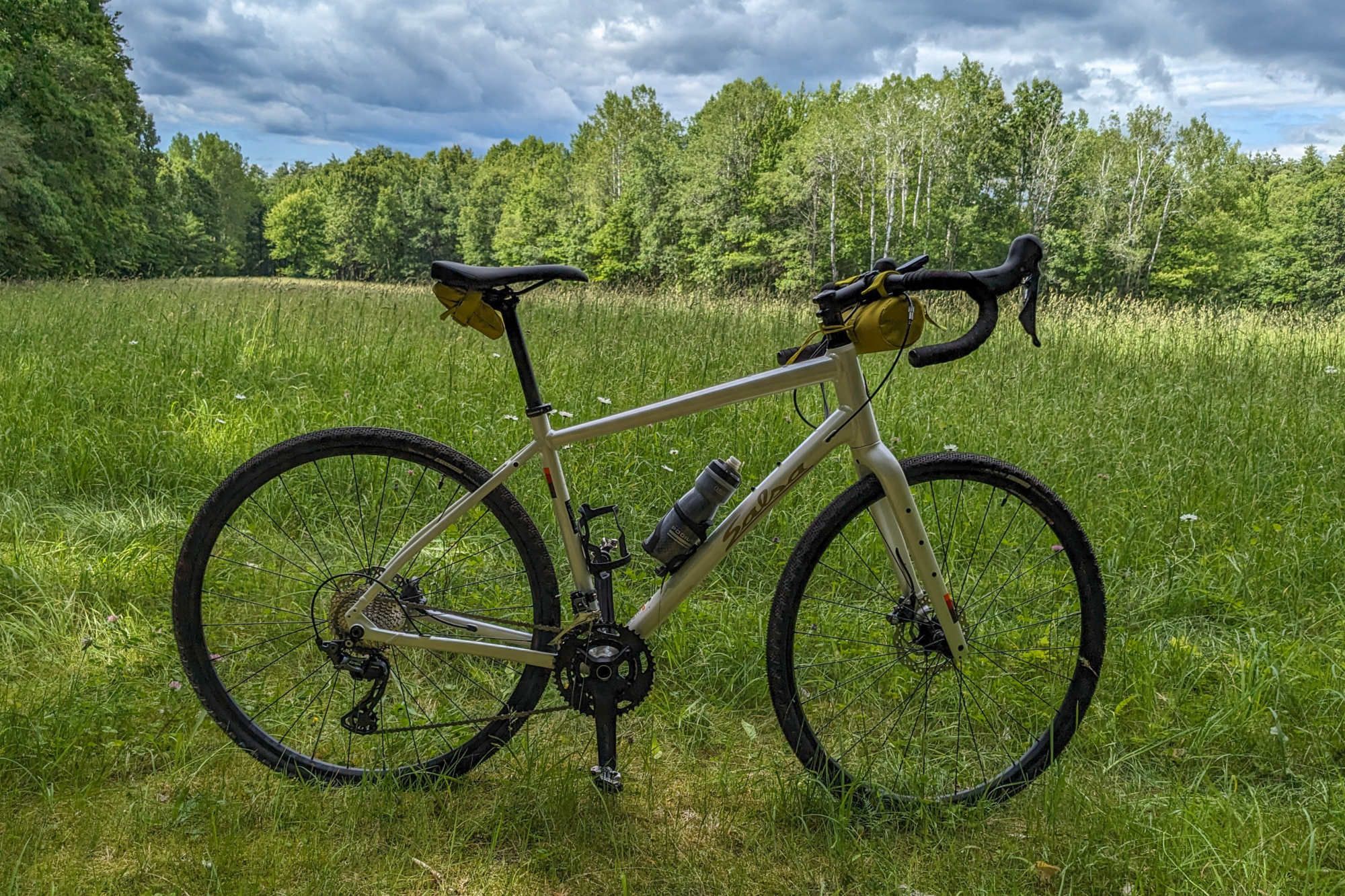
The Journeyer GRX 700c features an aluminum frame and carbon fiber fork and weighs in at just under 25 pounds. While not lightweight, I never found the heft a hindrance, even when tackling multiple-mile-long double-digit-grade climbs. Setting the bike up tubeless (something riders should consider doing) can shave a few ounces for those concerned by the bike’s weight.
The Journeyer’s geometry is conservative and keeps riders relatively upright. Salsa describes it as “stable and confidence-inspiring” and it’s hard to argue with the characterization. The Journeyer provides a stable and predictable ride that favors a more cautious riding style. It doesn’t really want to push the limits on descents and is better suited to slow, seated climbs than attacking hills. Stay in the Journeyer’s sweet spot and it delivers a very enjoyable ride.
Wheels and tires
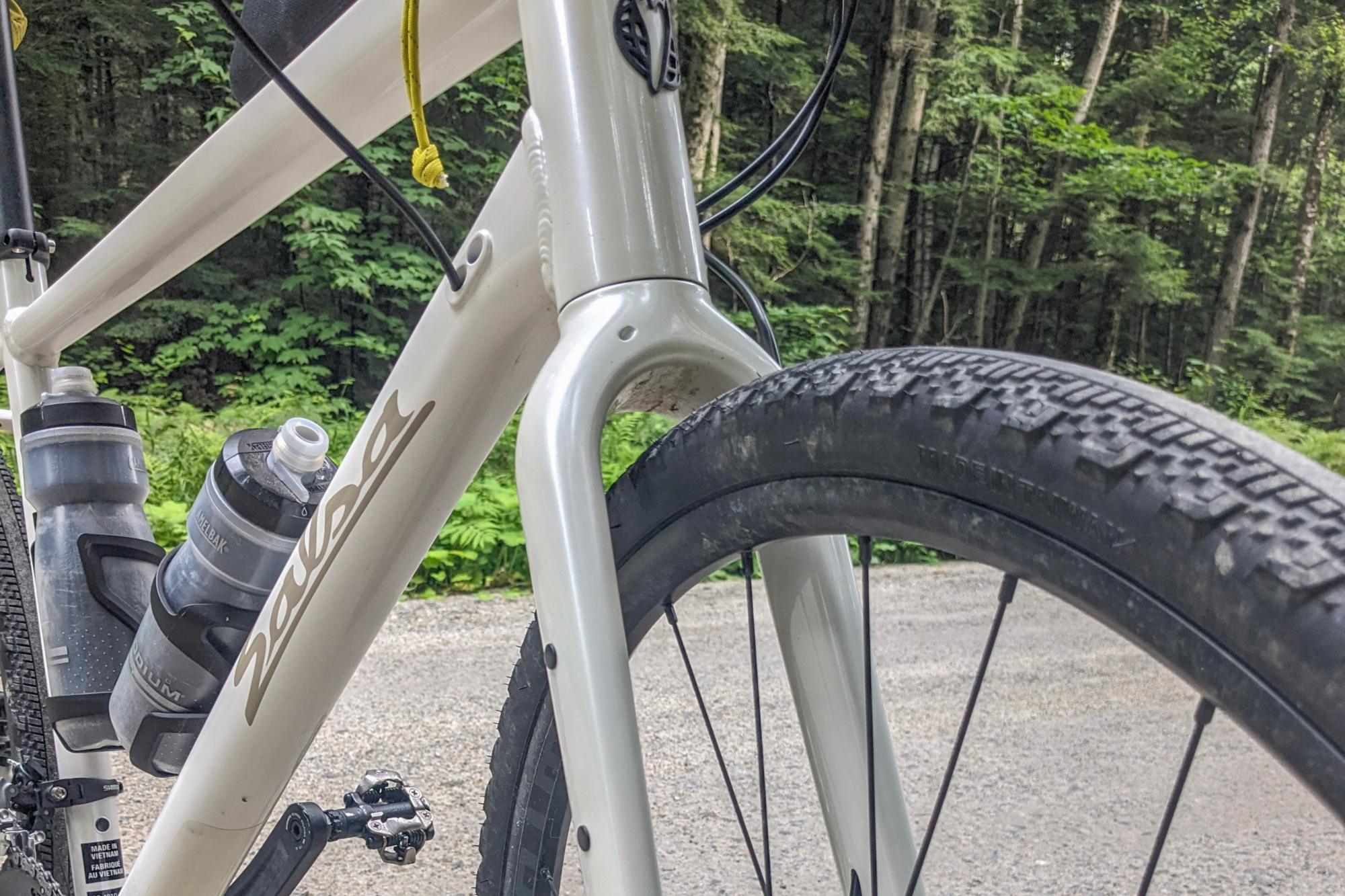
One area where the Journeyer could pick up some performance is with its tires. The bike comes with tubeless-ready WTB rims and Teravail Durable-Casing Washburn 700c x 38 mm tires, which is a nod to the versatility of the bike. The tires perform well on paved roads, bike paths, double track, and even some mild singletrack, but feel overwhelmed on speedy descents, in loose terrain, and when getting off the beaten path.
Those who spend a serious amount of time on dirt will benefit from moving to larger tires. The Journeyer can accommodate up to 50 mm tires and is compatible with 650b wheels. In other words, there’s a lot of room to experiment with rubber. Conversely, a set of slicks would make the Journeyer a nice option for bike touring.
The build
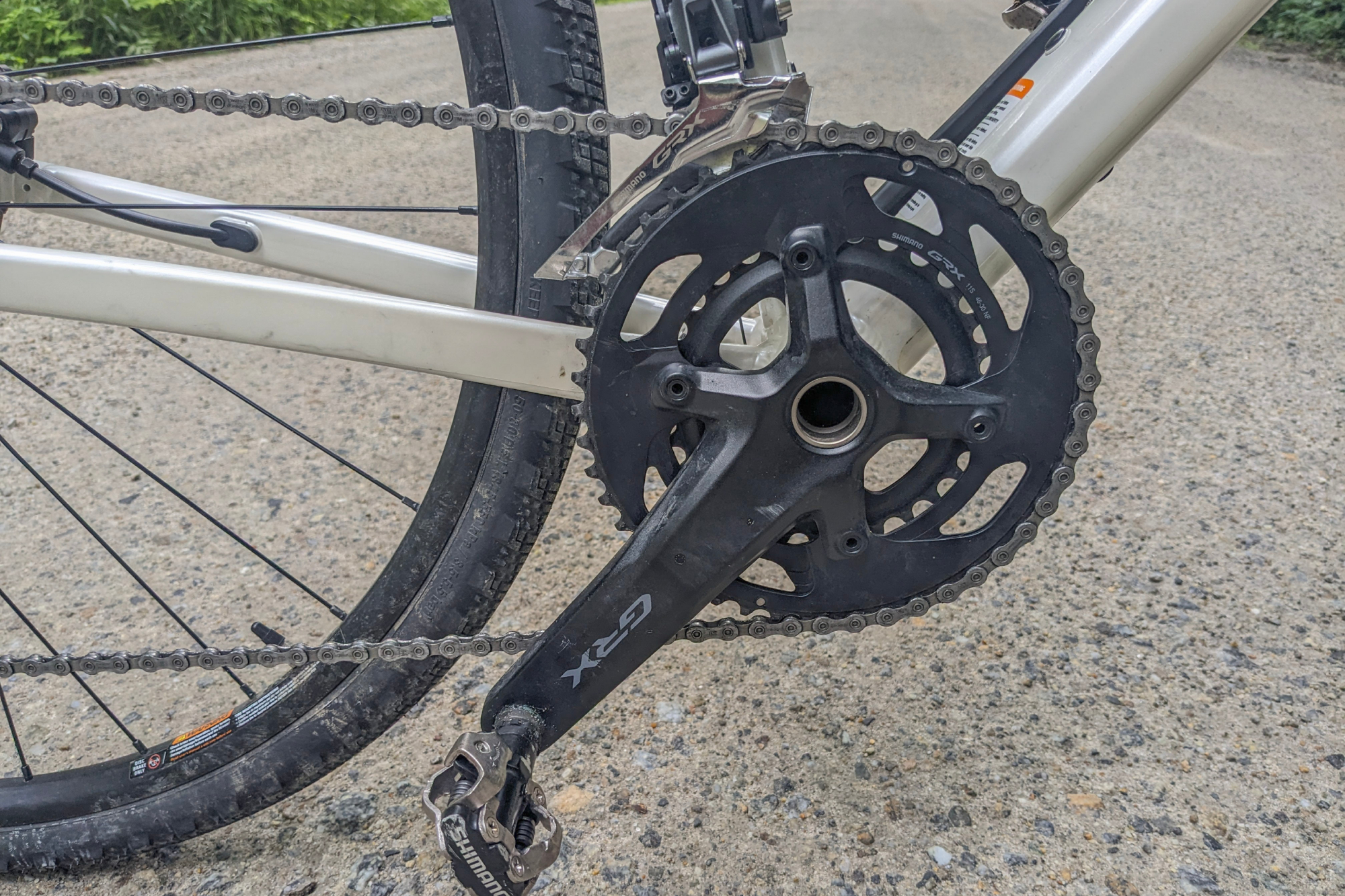
As its name implies, the Salsa Journeyer GRX 700c features a Shimano GRX groupset primarily consisting of a mix of GRX 400-, 600-, and 800- series parts. The brakes are hydraulic from Shimano’s 400 series and deliver ample stopping power and perform well in all conditions, from fresh blacktop after an afternoon storm to slick singletrack following repeated dunkings in a series of surprisingly deep puddles.
The brake/shift levers feel comfortable and shifting is smooth, precise, and predictable thanks to front and rear GRX 810 derailleurs. Its 2x drivetrain features 46/30-tooth chainrings in the front paired with an 11-speed 11–34 tooth cassette in the back. While on long descents I at times looked for a larger gear (and on more than one super-steep climb I wished for a smaller gear), the range seems right for the majority of riding.
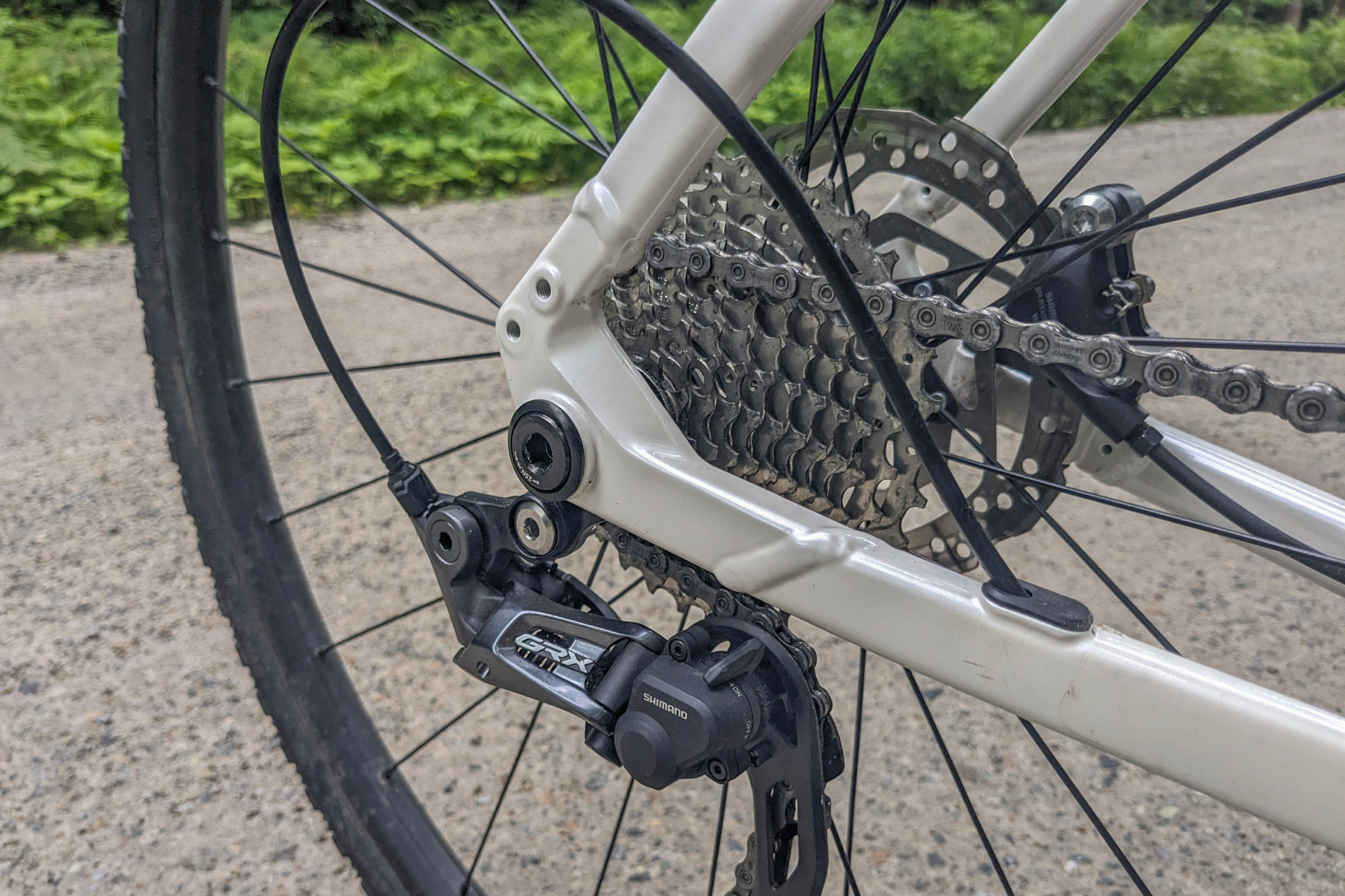
The cockpit
The cockpit is a collection of mostly Salsa parts and is highlighted by its Cowbell handlebar, which has a slight 12-degree flare and provides a number of comfortable hand positions, which riders using the Journeyer for biking and long adventurous rides are sure to appreciate. My one minor complaint is that the top of the bars feels a little narrow and, at times, cramped.
The cockpit is rounded out with a comfortable and nicely specced WTB Volt seat. The Journeyer frame is also routed for an internal dropper post. While a dropper isn’t included, this makes adding one later easy.
Cargo capacity
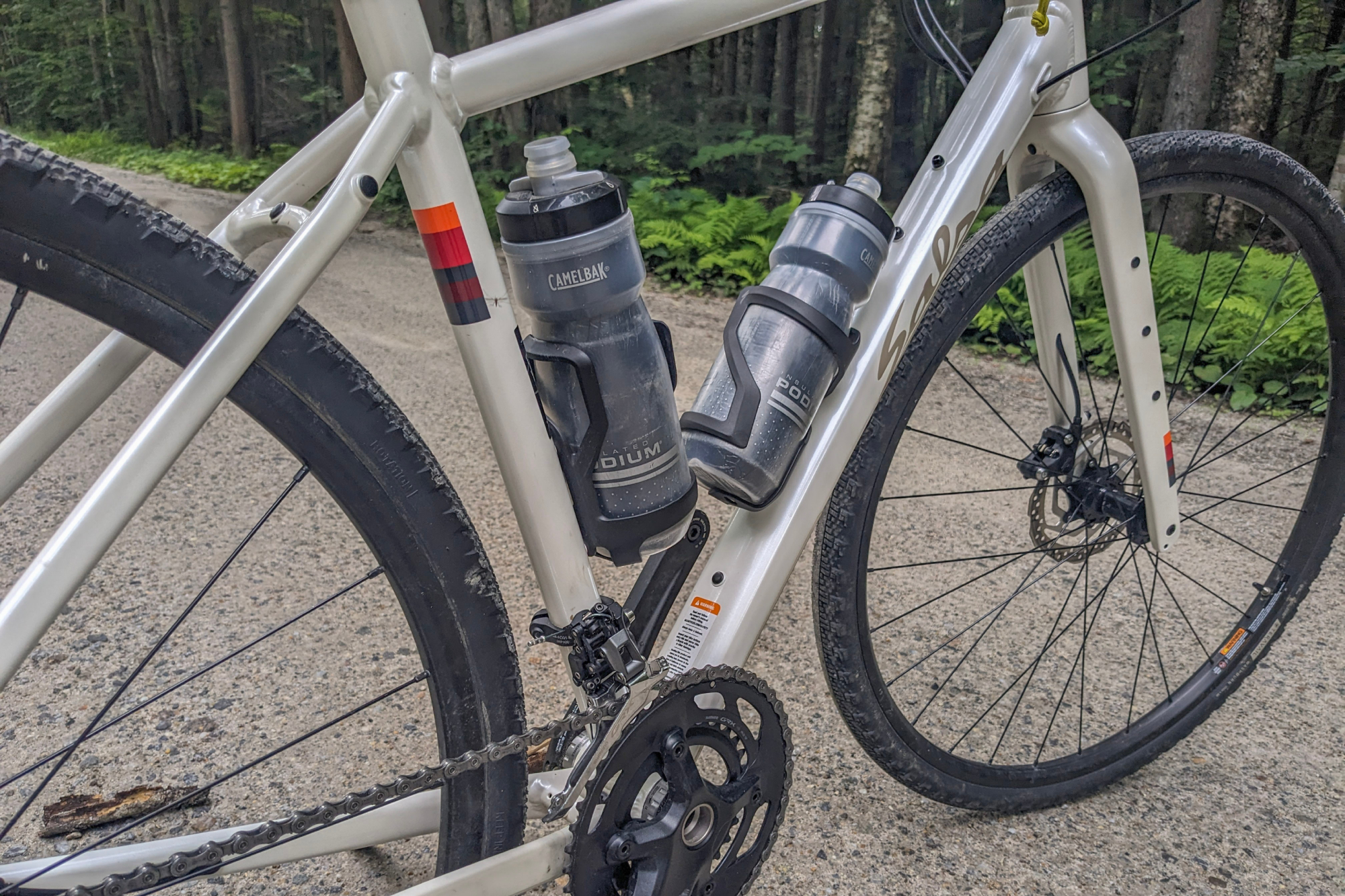
One of the highlights of the Journeyer is the numerous ways you can outfit it with bags and bottle cages. Salsa bills the bike as its “workhorse all-road adventure machine” and it’s justly equipped. It’s loaded with places to mount water bottles, bags, racks, and fenders—making it a great choice for those with ambitions of bikepacking, commuting, and remote all-day exploration. The Journeyer’s fork features three pack mounts, the top tube has a mount for a bag, and it’s compatible with both front and rear fenders and racks.
My 57cm test ride has three water bottle mounts in the main triangle (smaller sizes have only two) and another bottle mount on the underside of the down tube. A particularly nice touch is that the two primary water bottle mounts are easily moved up and down. Both have two mounting positions, which makes it easy to accommodate a variety of frame bags or, in the case of larger frames, a third bottle.
Salsa Journeyer 700c: the ride
The Journeyer isn’t a race bike like Salsa’s Warbird, nor does it gobble up off-road terrain like the company’s Cutthroat. What the Journeyer does is provide riders with a bike that is both capable and fun to ride in all sorts of terrain, whether it’s freshly laid pavement, Cadillac gravel, or rough seasonal roads.
I find myself routinely reaching for the Journeyer for everything from rides leaving from my driveway that involve a lot of asphalt to get to the goods, to classic regional gravel loops. I also still take the bike on a fair bit of singletrack—so long as you don’t push it too hard and stay within your limits, the bike can conquer some impressively rugged trails.
In my opinion, the Journeyer is at its best grinding out mileage on longer rides. Characteristics like its conservative geometry, comfy saddle, and the multiple hand positions provided by its Cowbell bar aren’t easily noticed on quick spins around the neighborhood but become greatly appreciated after a few hours in the saddle and a couple of thousand feet of elevation in your legs.
The Journeyer’s cargo capacity also lends itself to long rides. I logged the majority of miles on the bike during a brutally hot and humid New England summer—it felt like I had a third bottle in the main cage more often than I did two. I also rode the bike with a variety of bags, ranging from full bikepacking setups to just a half-frame bag for long rides in unpredictable weather. No matter how heavy it was loaded or how it was configured, the bike always felt stable and in control. Fully loaded, I was often shocked at how heavy the bike was when I reached for it after a break—I never noticed the extra weight while riding.
Salsa Journeyer: value and conclusion
The Salsa Journeyer is truly a do-it-all bike that is capable of instilling confidence on a variety of terrains. It doesn’t shine in any particular area, but its unpretentious performance is part of its charm. It’s good almost everywhere and really fun to ride.
The most impressive quality of the Journeyer is its versatility and ability to fulfill the needs of a number of different types of riding. Add some fenders and use it as a commuter, load it up with water and grind out a long remote loop, equip it with bags and take it bikepacking, or swap its rubber for some fat tires or 650b wheels and get rowdy.
The Salsa Journeyer is great for gravel-curious riders. It provides a platform to sample a broad spectrum of gravel riding without breaking the bank and lets riders discover the type of gravel grinding most appealing to them. In the end, the Salsa Journeyer isn’t the type of bike that’s going to win any races or rip singletrack, but it’s the type that gravel bike collections are built on.
There are few brands more synonymous with gravel than Salsa; the brand has been producing adventurous drop-bar bikes since before gravel was the next big thing. That said, you pay a premium when you purchase a Salsa bike. The Journeyer GRX 700c also comes in at the top of the market for budget-friendly gravel bikes.
For a few hundred dollars more, the Journeyer is a nice step up from a bike like the GT Grade Elite. However, the Diamondback Haanjo 7C Carbon is arguably a better value. It costs a few hundred more dollars and features a similar spec but with a carbon frame.

Thank you for reading 20 articles this month* Join now for unlimited access
Enjoy your first month for just £1 / $1 / €1
*Read 5 free articles per month without a subscription

Join now for unlimited access
Try first month for just £1 / $1 / €1
Get The Leadout Newsletter
The latest race content, interviews, features, reviews and expert buying guides, direct to your inbox!

Tim Peck is a freelance writer based in Concord, New Hampshire, specializing in writing about all things outdoors in the Northeast. With a devotion to dirt and a need for speed, it’s no surprise Tim went from gravel-curious to gravel-obsessed faster than a double-digit grade descent. Tim believes that days on the bike and miles logged are just as important as KOMs and race results and tries to balance his time between his first love, mountain biking, and his current flame, gravel riding.
-
 'This race is absolutely disgusting': Peloton reacts to another brutal Paris-Roubaix Femmes
'This race is absolutely disgusting': Peloton reacts to another brutal Paris-Roubaix FemmesNow in its fifth edition, Paris-Roubaix Femmes is still a tough race, even for the best bike riders in the world
By Adam Becket Published
-
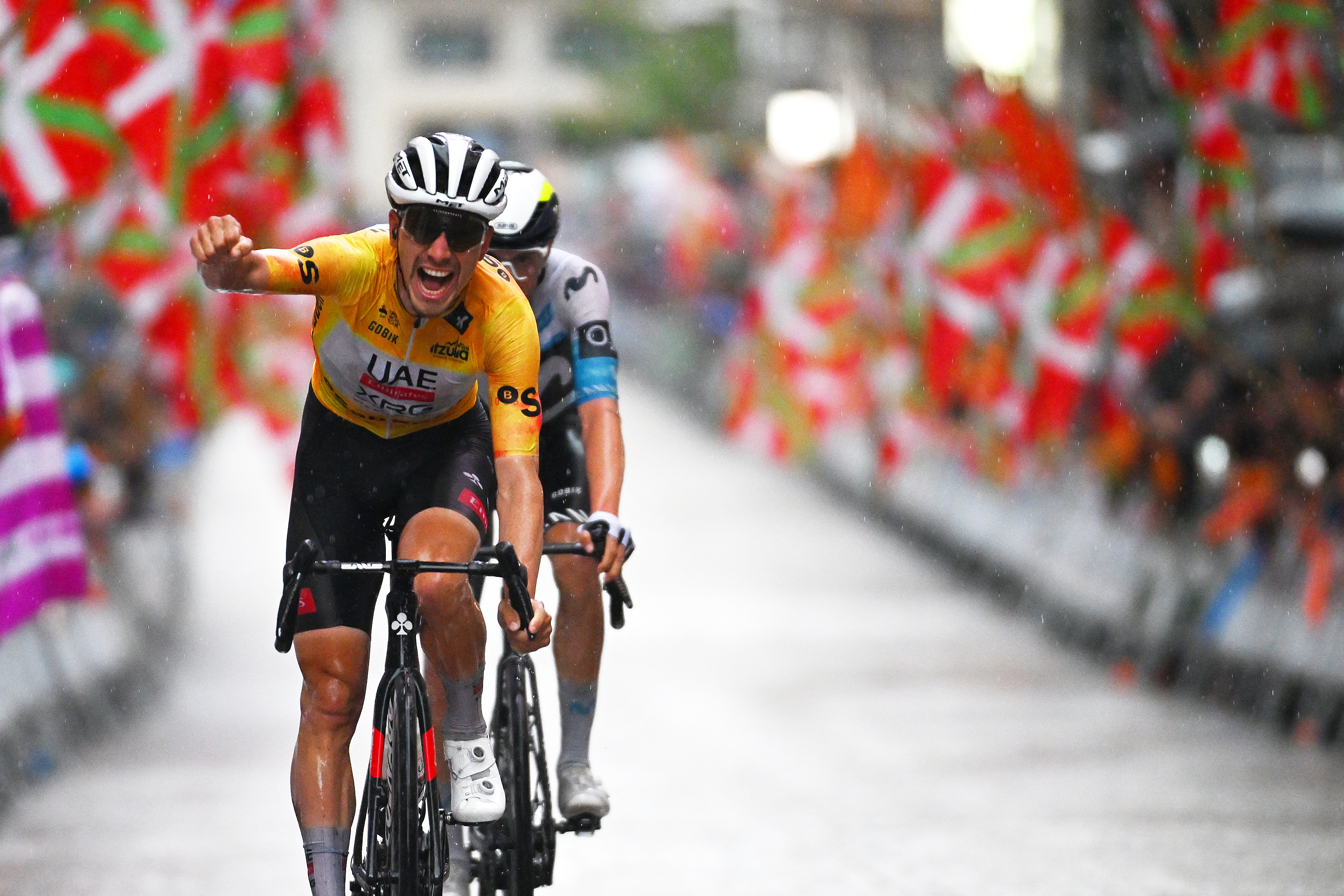 ‘It’s the biggest win of my career’ says João Almeida after crushing Itzulia Basque Country success
‘It’s the biggest win of my career’ says João Almeida after crushing Itzulia Basque Country successUAE rider wins the final stage to finish almost two minutes clear of Enric Mas on GC, with Max Schachmann in third
By Peter Cossins Published
-
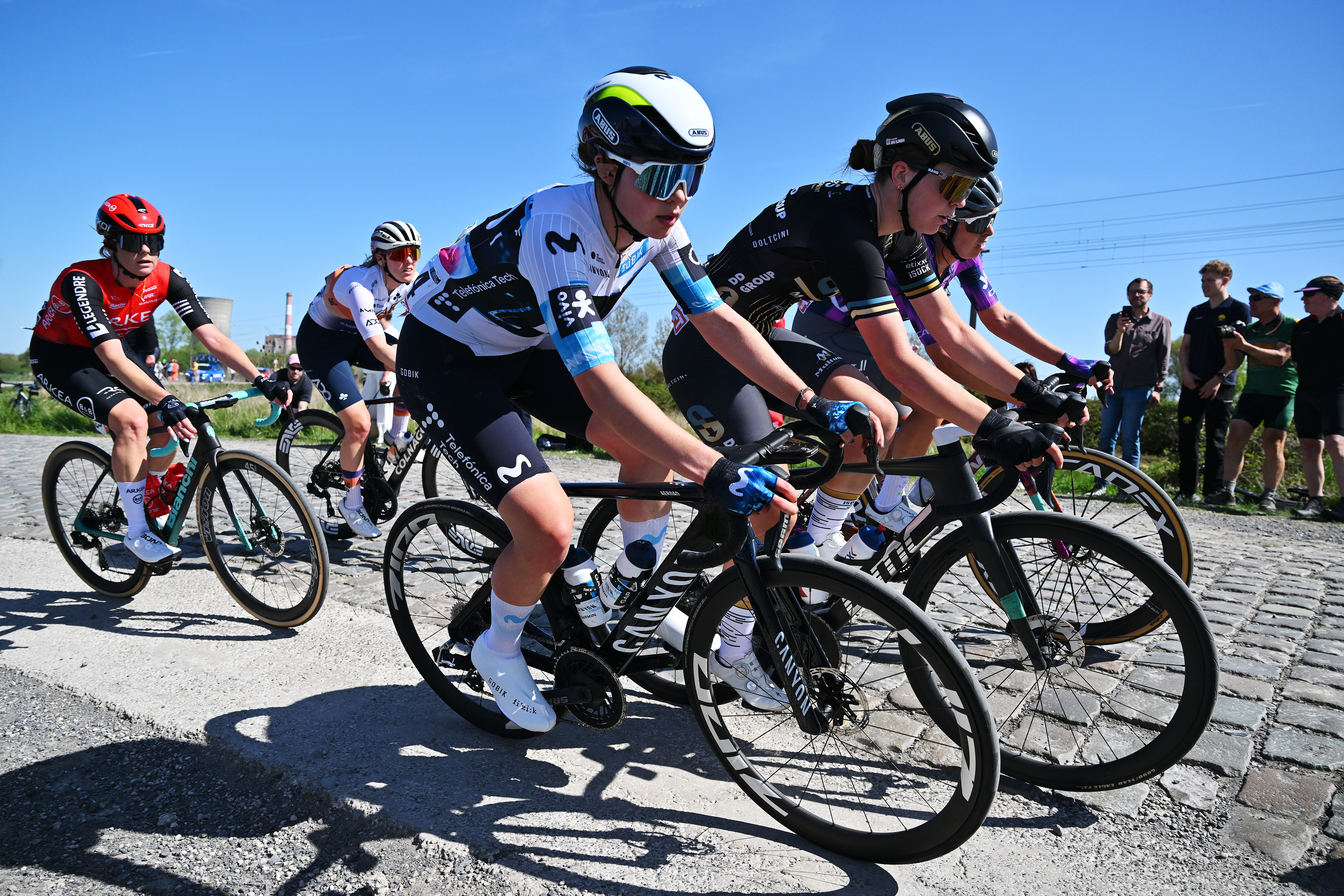 'I have an exam in a month and a half' - Carys Lloyd becomes Paris-Roubaix's youngest ever rider
'I have an exam in a month and a half' - Carys Lloyd becomes Paris-Roubaix's youngest ever riderBritish teenager and A-Level student makes it to the velodrome on debut
By Tom Davidson Published